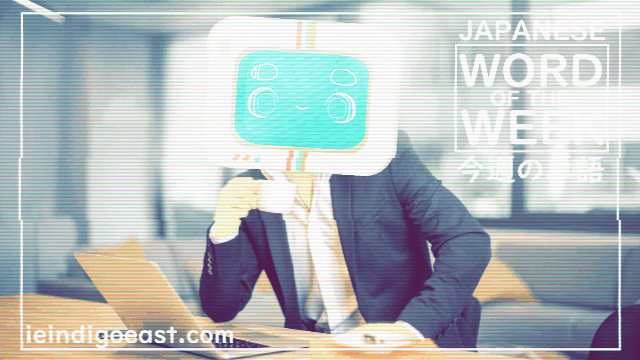
HELLO! I AM QUIZBO™! Welcome to the seventeenth instalment of this special corner: January Japanese Word of the Weekday presented by Kiki+Koko: Let’s NihonGO!! Online. During the month of January, we are providing new learning opportunities every weekday all month long. However, it does not have to be the beginning of the year or even the beginning of a month to begin to challenge yourself in order to form positive habits in order to reach your Japanese language learning goals.
Everyone may not have the same goals when it comes to learning Japanese language. There are many who simply want to be able to communicate casually with friends and family, others who would like to enjoy media in Japanese language, and many who simply want to experience a new language for brain health and mental exercise. However, many more begin to learn Japanese language with the goal of becoming fluent. Today, we will be joined by Kiki and Koko with a different kind of quick helpful hint meant for your Japanese language learning journey as a whole rather than just today’s vocabulary.
Speaking of which, it is time to encounter today’s Word of the Weekday! Let us NihonGO!!
Word(s) of the Weekday:
流暢【りゅうちょう】
ryuuchou
Na adjective (ナ形容詞), Noun (名詞)
- fluent (in a language) ; fluency; in a flowing style (literary)
JLPT N2 |common words (常用語)
This vocabulary word may be difficult to pronounce for many absolute beginners. But, do not worry! Though it is important to start from the beginning when it comes to many lesson series, you should still be able to gain a decent understanding of these sounds and concepts with the following lessons:
You may take a moment to go over these lessons, or save them for later.
In the meantime, please standby for a short commercial break. We will be back with “Helpful Hints with Kiki+Koko” after these messages!
And, we are back with Helpful Hints with Kiki+Koko!
As a note, there are several ways to convey the idea of fluency, however this is the most fitting in both formal and conversational context. Now, without further ado, let us welcome back Kiki and Koko with their Helpful Hints.
Helpful Hints with Kiki+Koko:

Hello, there!
We’re Kiki+Koko, your guides to Japanese language and culture, helping you on your Japanese language learning journey every step of the way! Before you begin any journey, usually you have a destination in mind, whether a day trip or a month-long excursion. Usually, when someone wants to learn a new language, they automatically set their goal as becoming fluent in the language. But, is this a realistic way to think about language learning?
What does fluency mean? Does it mean being able to say a few phrases or hold a short conversation? Does it mean being able to read at a specific level? Or does it mean being able to communicate your thoughts and feelings in equal proficiency to your native language? Well, for everyone it seems to have a different definition.
The idea of fluency is something very nebulous. And, even those who pass the 日本語能力試験(にほんごのうりょくしけん), or the Japanese Language Proficiency Test, referred to as the JLPT, at N1 proficiency, the highest of the 5 levels for the JLPT, find themselves questioning what it means to be fluent. Those who reach doctorate levels of Japanese language skills feel like “fluency” is still not in their reach despite every native speaker around them perhaps seeing the speaker as sounding indifferentiable from native speakers. But, these are cautionary tales for beginners and experts alike.
When it comes to learning, even in your native language, there will always be a new word that you didn’t know or a new slang that’s formed. There will always be a new phraseology or an idiom you’ve never heard. But, we’re here to tell you…that’s…the point of it all.
Living is learning. There will never be a time where you are completely omniscient or a time where there’s nothing left to learn about a subject. Expert musicians still practise scales; educators continue attending school; and people who know any language will always have something new to learn.
That is why we stress that you celebrate each accomplishment along the way to your goals. Whether it’s learning a new word or finally memorising a character’s stroke order, whether it’s one concept or one hundred, it is worth celebrating, as learning one thing today is one more thing than you knew yesterday.
Last instalment, we talked about 目標(もくひょう・mokuhyou) and 目的(もくてき・mokuteki). And, though it’s great to stay focussed on your overall 目的(もくてき・mokuteki), it’s important to stop and appreciate the 目標(もくひょう・mokuhyou) along the way. Or else, you’ll go your entire journey without having appreciated how far you’ve travelled.
We hope that helps!! Until the next lesson!
♡Kiki+Koko
Thank you, Kiki and Koko, for your insight on the nebulousness of fluency and the importance of being present in your Japanese language learning journey. Learning is a lifelong journey, but that means that you will have a lifetime of enjoyment and mental exercise to gain from learning another language. So, let us continue in said journey by looking at a few sentences that exemplify the usage and meaning of today’s vocabulary.
Example #1:
A: はあ、日本語を流暢に話したいなあ・・・
はあ、にほんごを りゅうちょうに はなしたいなあ・・・
Haa, nihongo wo ryuuchou ni hanashitai naa…
Sigh, I want to speak Japanese fluently…
B: どうするつもりか?
どうするつもりか?
dou suru tsumori ka?
What are you going to do about it?
A: なんてそっけなく答えですよ。
なんてそっけなくこたえですよ。
nante sokkenaku kotae desu yo.
What a curt answer.
B:助言だもん。オレがいつも言ってるように:
じょげんだもん。 おれが いつも いってるように:
jyogen da mon. ore ga itsumo itteru you ni:
It’s advice. As I always say:
何もしないと、何にもなりはしないよ。
なにもしないと、なにもなりは しないよ。
nanimo shinai to, nanimo nari wa shinai yo.
If you don’t do anything, nothing will happen.
A: それをぜんぜん言ったことがないの。
それをぜんぜん いったこと ないの。
sore wo zen zen itta koto nai no.
You’ve never said that before.
B:そんな態度じゃ 無理だぜ~
そんな たいどじゃ むり だぜ~
sonna taido jya muri da ze~
Not with that attitude~
Example #2:
流暢の語義って曖昧ですね。あなたはちゃんとコミュニケーションができれば、自分自身に誇りを持てるだと思いますが、私は知識を磨くにずっと学び続けるつもりです。
りゅうちょうのごぎって あいまいですね。 あなたは ちゃんと こみゅにけーしょんが できれば、じぶんじしんに ほこりを もてるだと おもいますが、わたしは ちしきを みがくにずっと まなび つづけるつもりです。
ryuuchou no gogi tte aimai desu ne. anata wa chanto komyunikeeshon ga dekireba, jibunjishin ni hokori wo moteru da to omoimasu ga, watashi wa chishiki wo migaku ni zutto manabi tsudzukeru tsumori desu.
The definition of fluency is ambiguous, isn’t it. I think you can be proud of yourself if you can communicate properly, but I will continue to learn to improve my mind.

Well, that is all of the time we have for today’s instalment of Kiki+Koko: Let’s NihonGO!! Online’s Japanese Word of the Weekday! It is the hope that you will continue to join us for more of this special corner as well as more of our Japanese language and culture resources. Just because the activity of today is complete does not mean that your daily learning journey has to stop here. You can have a look at previous Word of the Week articles for even more Japanese vocabulary. You can be sure that you are caught up with the latest by visiting ieindigoeast.com, and clicking the sidebar link labelled 今週の単語 | Word of the Week, or go to ieindigoeast.com/kikiandkokoletsnihongo and scroll down until you see a smiling blue face on the Word of the Week banner, and you can access the archives. (That is the face of me!)
Be sure to subscribe to our Electronic Mailing List of Tomorrow, today, using the form at the bottom of the web page so you can be the first to see the latest from Kiki+Koko: Let’s NihonGO!!, Indigo East, and SpeRaToBo. And, remember to return back to previous articles and lessons to review/revise. Also consider following our new page on Twitter and Instagram to support the spread of this site in a friendly domination of Earth that will help more people. Or, if you are enjoying the content that we are creating, or want to spread this content to more people to be able to access it for free, you can join our patreon, patreon.com/ieindigoeast or you can leave a TIP in the TIP♡JAR to keep it going with no strings attached. If you cannot support in this way, then we are just super happy that you are here anyway! It supports the content when you participate, and it is appreciated!
Thank you so much for learning with us!
♡QUIZBO™






Follow SpeRaToBo || ieindigoeast on WordPress.com
Categories: スペシャル | Specials!, SpeRaToBo, 一月の毎平日の単語|Word of the Weekday

































